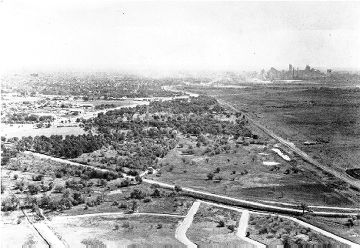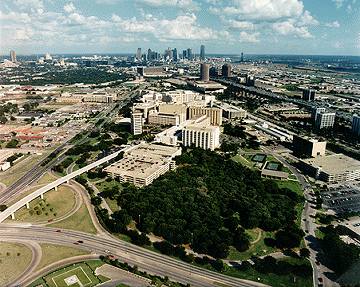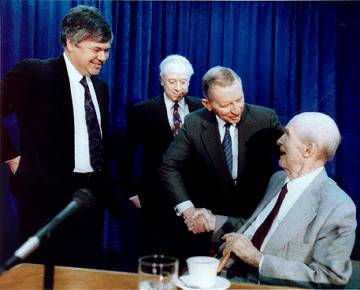
Frederick Grinnell
UT Southwestern Medical Center
In early 1985, when philanthropist Ralph Rogers spoke with Texas billionaire Ross Perot to ask for a “considerable” amount of money for UT Southwestern Medical School, he anticipated no great difficulty. Rogers, who recently had led the $80 million campaign to modernize Parkland Memorial Hospital, was friends with Perot and knew Perot to be interested in supporting “world class” institutions. By most criteria, UT Southwestern already had become a world class institution, indicated for instance by the election of six of its faculty members to the National Academy of Sciences during the preceding six years, and the signing in January, 1985 of an agreement with the Howard Hughes Medical Institute to establish a unit at the medical center. Perot declined to make the requested donation, however, saying “that perception is more important than reality (and) Southwestern is not perceived as world class” (1). That perception changed in October when Michael Brown and Joseph Goldstein won the 1985 Nobel Prize in Physiology and Medicine.
The Nobel Prize, wrote Harriet Zuckerman in The Scientific Elite (2), is the “gold standard by which all other scientific awards are judged. . . (the) universal and instantly understood metaphor of supreme achievement.” As soon as he heard the announcement of the award to Brown and Goldstein, Rogers called Perot. Getting on the phone, Perot laughed, saying “When I walked into the office this morning, I told all of my associates that I would be hearing from Ralph Rogers today. I said that this was going to cost me” (1). And so it did — almost $50 million by 1996.
This essay is partly about the impact of the Brown/Goldstein Nobel Prize on UT Southwestern, but just as much about the developments at UT Southwestern that made possible the Nobel Prize. When Nature ran a news brief after the award was announced, the writer commented on the inability of “more distinguished institutions” to lure Brown and Goldstein away from Dallas (3). How did a world class medical center develop in Dallas, Texas? What was it about the “evocative environment” (2) at Southwestern that encouraged the growth and development of two assistant professors who started out with minimal resources. What kept them from being lured away?
The story that answers these questions begins shortly after the turn of the century. In those days, medical education in the United States was in transition. The highly acclaimed 1910 report on medical education prepared for the Carnegie Foundation by Abraham Flexner (4) was critical of medical schools nationwide and called for extensive changes. Texas was no exception. Flexner wrote:
There is now only one educational institution in
the state [of Texas] whose graduates deserve the right
to practice amongst its inhabitants [University of
Texas Medical Branch at Galveston] . . .The other three
schools are without resources, without ideals, without
facilities. . .(4)
In 1901, Dr. Edward Cary — later a major figure in American medical politics — returned to Dallas after completing his medical training at Bellevue in New York. Cary joined the Dallas Medical Department, which became Baylor University Medical College. As dean, he played a role in the affiliation of the medical college with Parkland Hospital for “needy persons” (1913) and the takeover of Southwestern Medical College (1915). The following year Cary organized the Greater Medical Center campaign of Dallas, which raised $500,000. His stated his goal was to make Dallas one of the seven great medical centers of the United States (5).
Baylor Medical College in Dallas didn’t develop beyond its modest origins. On the contrary, 20 years later the school had a deteriorating physical plant and class enrollment was on the decline. Cary, however, was still dreaming about “a truly great Southwestern Medical Center” (5), which could only develop through sustained philanthropic support. The initial instrument to turn this dream into reality would be the Southwestern Medical Foundation, which Cary and Texas theater magnate Karl Hoblitzelle founded “to perpetuate medical education and scientific research in an assured nonsectarian environment” (5).
The Foundation originally envisioned operating a re-vitalized medical school in partnership with Baylor University. When Baylor backed out and moved to Houston, Cary and Hoblitzelle went forward anyway. The Foundation opened Southwestern Medical College in 1943 and purchased land for a new school facility along Harry Hines Boulevard just north of downtown Dallas (Figure 1), which was adjacent to the site where a new multi-million-dollar Parkland Hospital was planned. Afterwards, behind-the-scenes maneuvering combined with skillful lobbying of the Texas Legislature led to the selection of Southwestern Medical College as the second University of Texas medical school (1949).

Figure 1: Circa 1946: Aerial view facing southeast showing the future site of Southwestern Medical College and Parkland Hospital (1946-47 Yearbook of Southwestern Medical College). The medical center was to be built along Harry Hines Boulevard just south of Inwood Road (intersection left center).
When Don Seldin, who was to become “one of the dominant intellectual forces in American medicine” (6), joined the faculty at University of Texas Southwestern Medical College in 1951, work on the new medical school had yet to begin. “The facilities [prefabricated army barracks called “the shacks”] were incredibly primitive,” recalled Seldin. “I had never seen anything like it” (7). Two years later, Seldin was the only one left in the department of medicine, and he became acting chairman. The situation was not without its possibilities, however.
. . .there was no faculty to replace because there
was no faculty. . .there was an opportunity to
be innovative, to start new things, to develop new
kinds of programs. . . there was an opportunity
to instill a certain sense of style into the
program (8).
If Cary provided the original vision for a great medical center in Dallas, Seldin came to embody its style — its philosophy. The importance of combining medical practice with medical science was one of the key points emphasized in the 1910 Flexner report. Practice and scientific investigation were “one in spirit, method, and object.” Flexner was prepared, however, to understand a separation between practice and investigation as a “practical difficulty due to the necessity for a division of labor” (4). Such a separation was unacceptable to Seldin. “I believe,” Seldin wrote:
that every member of the faculty in the clinical
department is responsible for investigative
activity, because this is the key point of the
educational process. This is the method of
ascertaining truth. . . If the individual teacher
is not a scholar, what entitles him to operate
within the university framework? Is it his charm?
Is it his vividness? . . . The necessary
qualification of the scholar is that he in some
sense exhibit the imaginative type of activity
that is inherent in the research process (9).
So Seldin set out to create a department of clinical scholars. With no money, there was little possibility for bringing in outside talent. Consequently, the chairman adopted a different strategy. He selected his best students and residents, sent them off for additional training, and then brought them back to Dallas as faculty members. Joe Goldstein as a medical student (1962-66) was Seldin’s pick for head of medical genetics. Later, before leaving his residency at Massachusetts General Hospital, Goldstein convinced Mike Brown to go to Southwestern as well.
As it turned out, Seldin and his colleagues were stuck in the shacks for several more years. The new building wasn’t dedicated until January, 1955. The fledgling medical school was on the move, however, aided in no small part by the rapid expansion of support for basic research then underway in the United States. By 1960, the U.S. spent more on R&D as a percentage of GNP than any other country (10). For schools like Southwestern, the competitive merit review system for funding individual projects was critical. This system favored excellence over entitlement and aimed for the expansion of the academic research centers throughout the country (11).
By the time Charlie Sprague became dean of Southwestern in 1967, Southwestern’s annual budget had grown from $500,000 in 1949 (12) to $10 million, and the clinical science departments had achieved national prominence. The new dean’s priorities were expansion of the physical plant and development of the basic sciences, both of which became part of his proposal to expand Southwestern Medical School into a “Life Sciences Center” (12). Sprague’s plan called for building a million square feet of new space, more than doubling the size of the existing campus.
Funding for the $40 million expansion project came mostly from the State of Texas and the Federal Government, but the project was $7.5 million short. Once again, the Southwestern Medical Foundation organized a major fund-raising drive. When medical school faculty members arrived at the “kick-off breakfast” to begin the campaign, they learned that commitments made by the Dallas philanthropic community had already surpassed the target goal by $1 million. Occupancy of the new buildings began in 1972. The medical school was now a health sciences center with Sprague as its new president, a position he held until his retirement in 1986, the year after Brown and Goldstein won the Nobel Prize.
To bring the basic science departments up to the level of the clinical sciences required — a least for a time — disproportionate allocation of resources. That meant, for instance, that the first phase of the building program went largely to the basic science departments. The practical willingness of the clinical departments under Sprague’s leadership to share resources with the basic sciences matched the intellectual relationship between clinical and basic science called for by Seldin’s philosophy. Taken together, these practical and intellectual commitments resulted in the high level of collegiality that came to typify UT Southwestern. The extent of mutual respect, support, and cooperation between faculty in diverse departments at UT Southwestern is quite unusual compared to that found in most universities. Mike Brown alluded to this collegiality when he said that the Nobel Prize-winning work done by himself and Joe Goldstein could not have been accomplished at any other institution (7).
Over the years, many institutions tried to recruit Brown and Goldstein. There was a time in 1977, when the researchers seriously considered leaving UT Southwestern and accepting a particularly lucrative offer they had received from another distinguished medical center. Although unable to match the beneficence of the other proposal, Southwestern responded by offering Brown and Goldstein their own department, and Seldin gave them one of Internal Medicine’s endowed chairs. The deciding factor that kept them in Dallas, however, was a meeting with Erik Jonsson — fifty stories up — at the top of the Republic National Bank Building. Jonsson was one of the co-founders of Texas Instruments and, as mayor of Dallas (1964-1971), instrumental in the development of Dallas/Fort Worth International Airport. Jonsson shared his vision of Dallas’ future with the researchers and promised them the support of the leaders of Dallas. Brown and Goldstein became part of the vision.
During Charlie Sprague’s tenure as president, the medical center’s annual budget grew from $10 million to $183 million, sustained in significant part by ever-increasing appropriations from the Texas Legislature to support medical education and research at UT Southwestern — from less than $5 million/year in 1965 to more than $60 million/year in 1985. State-wide economic constraints mounted, however, and the same year that Kern Wildenthal succeeded Charlie Sprague as president, the medical center was confronted with a 13% decline in State support.
“Four essential factors determine the ability of an organization to attract the best and brightest recruits,” wrote Wildenthal in an essay about the key to success of an organization, “Money, facilities, colleagues, and organizational vision and commitment” (13). In 1986, the problem was money. Faced with looming constraints in State spending as well as ever-increasing competition for Federal dollars, Wildenthal focused his fund-raising efforts on the Dallas philanthropic community.
The “new” perception of UT Southwestern made possible by the Brown/Goldstein Nobel Prize had come just at the right time. “Perot lauds 2 Nobel laureates,” read the headline on the front of the Dallas Morning News Metropolitan section on 10 January 1986. The story told how the business and civil leaders of Dallas gathered “to hear Perot and other speakers . . . praise the individuals and the institution that brought Texas its first home-grown Nobel Prize.” In a sense, that celebration was the start of what was to become Dallas’ largest and still on-going fund-raising campaign to support biomedical education and research.
 |
| Figure 2: 6 June 1995: Aerial view facing southeast showing UT Southwestern Medical Center campus stretching south from Inwood Road along Harry Hines Boulevard. Photo: by Dave Gresham |
Under Wildenthal’s leadership, endowments to UT Southwestern have increased ten fold to over $400 million since 1986. More than 100 new endowed Chairs and Professorships have been established, and a $70 million referral hospital and $30 million outpatient facility have been added to the original campus, which now stretches for a half mile along Harry Hines Boulevard (Figure 2). In addition, the first two buildings of a new six building research complex costing $500 million have been constructed just north of the original campus on forty acres of land donated by the MacArthur Foundation of Chicago.
Continued success of other Southwestern scientists have helped sustain the campaign. Johann Deisenhofer won the Nobel Prize in chemistry in 1988, and Alfred Gilman won the 1994 Nobel Prize in Physiology and Medicine making UT Southwestern home to more Nobel Prize winners than any other medical school. The once-struggling medical center is now elite amongst the elite universities.
In a way, Figure 3 sums up the impact of the Nobel Prize on UT Southwestern. This photograph — printed by the Dallas Morning News in a story about the life and times of Erik Jonsson published after Jonsson’s death in 1995 — was one of the most prominent in the article, and the only one that illustrated Jonsson’s philanthropy. The caption read “Ross Perot congratulates J. Erik Jonsson for giving $30 million to the University of Texas Southwestern Medical Center in 1991 while Nobel Prize winners Drs. Michael Brown and Joseph Goldstein look on.”

Figure 3: Philanthrophy and the Nobel Prize. See text for details. Left to right: Michael Brown, Joseph Goldstein, Ross Perot, and Erik Jonsson.
Photo: Courtesy of Dallas Morning News
Acknowledgements
I am indebted to Frederick Bonte, Michael Brown, Ronald Estabrook, Joseph Goldstein, Donald Seldin, Charles Sprague, Paul Srere, and Kern Wildenthal for their suggestions regarding the contents of this essay and to Roy Bode and William Snell for their editorial assistance.
References
1. Rogers, R.B. (1993) Splendid Torch Pheonix Publishing, West Kennebunk, ME
2. Zuckerman, H. (1996) Scientific Elite: Nobel Laureates in the United States, Transaction Publishers, New Brunswick, NJ
3. Newmark, P. (1985) Cell cholesterol wins the day. Nature 317: 569.
4. Flexner, A (1910) Medical Education in the United States and Canada: A Report to the Carnegie Foundation, D.B. Updike, The Merrymount Press, Boston, MA
5. Mooney, B. (1948) More Than Armies: The Story of Edward H. Cary, Mathis, Van Nort and Co., Dallas, TX
6. Hayes, T.C. (1988) Just what the doctor ordered. New York Times, February 13.
7. Nobel Celebration Book, January 9, 1986, UT Southwestern, Dallas, TX
8. Lyon, P. (1986) An institution comes of age, In: Biologue UT Southwestern Office of Publications, Dallas, TX, pp 4-9
9. Seldin, D.W. (1959) The clinical teacher: Scholarship as the heart of the educational process, In: Report of the First Institute on Clinical Teaching, AAMC, Evanston, IL, pp 80-85
10. Smith, B.L.R. (1990) American Science Policy Since World War II, The Brookings Institution, Washington, D.C.
11. President’s Science Advisory Committee (1960) Scientific Progress, The Universities, and the Federal Government, U.S. Government Printing Office, Washington, D.C.
12. Schulze, C. (1971) What happened during 1943-1968: The first twenty-five years at Southwestern Medical School in Dallas. UT Southwestern Library Archives, Dallas, TX
13. Wildenthal, K. (1992) Recruiting for excellence, Dallas Business Review, Summer, 1994, pp 32-35
First published 23 June 1997